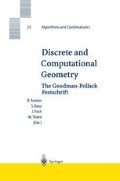Abstract
We introduce a new measure for planar point sets S that captures a combinatorial distance that S is from being a convex set: The reflexivity p(S) of S is given by the smallest number of reflex vertices in a simple polygonalization of S. We prove combinatorial bounds on the reflexivity of point sets and study some closely related quantities, including the convex cover number k c (S) of a planar point set, which is the smallest number of convex chains that cover S, and the convex partition number k p (S), which is given by the smallest number of convex chains with pairwise-disjoint convex hulls that cover S.
Access this chapter
Tax calculation will be finalised at checkout
Purchases are for personal use only
Preview
Unable to display preview. Download preview PDF.
References
P. K. Agarwal. Ray shooting and other applications of spanning trees with low stabbing number. SIAM J. Comput., 21:540–570, 1992.
P. K. Agarwal, E. Flato, and D. Halperin. Polygon decomposition for efficient construction of Minkowski sums. Comput. Geom. Theory Appl., 21:39–61, 2002.
A. Aggarwal, D. Coppersmith, S. Khanna, R. Motwani, and B. Schieber. The angular-metric traveling salesman problem. In Proc. 8th ACM-SIAM Sympos. Discrete Algorithms, pages 221–229, 1997.
O. Aichholzer, F. Aurenhammer, and H. Krasser. Enumerating order types for small point sets with applications. In Proc. 17th Annu. ACM Sympos.Comput. Geom., 2001, pp. 11–18.
O. Aichholzer and H. Krasser. The point set order type data base: a collection of applications and results. In Proc. 13th Canad. Conf. Comput. Geom., Waterloo, Canada, 2001, pp. 17–20.
[6] O. Aichholzer and H. Krasser. Personal communication, 2001. 154 E.M. Arkin et al.
N. Amenta, M. Bern, and D. Eppstein. The crust and the ¦Â-skeleton: Combinatorial curve reconstruction. Graphical Models and Image Processing, 60:125–135, 1998.
E. M. Arkin, S. P. Fekete, F. Hurtado, J. S. B. Mitchell, M. Noy, V. Sacristán, and S. Sethia. On the reflexivity of point sets. arXiv:cs.CG/0210003, 2002.
T. Auer and M. Held. Heuristics for the generation of random polygons. In Proc. 8th Canad. Conf. Comput. Geom., pages 38–43, 1996.
[10] B. Chazelle. Computational geometry and convexity. Ph.D. thesis, Dept. Comput. Sci., Yale Univ., New Haven, CT, 1979. Carnegie-Mellon Univ. Report CS-80–150.
B. Chazelle. On the convex layers of a planar set. IEEE Trans. Inform. Theory, IT-31(4):509–517, July 1985.
T. K. Dey and P. Kumar. A simple provable algorithm for curve reconstruction. In Proc. 10th ACM-SIAM Sympos. Discrete Algorithms, pages 893–894, Jan. 1999.
T. K. Dey, K. Mehlhorn, and E. A. Ramos. Curve reconstruction: Connecting dots with good reason. In Proc. 15th Annu. ACM Sympos. Comput. Geom., pages 197–206, 1999.
D. P. Dobkin, H. Edelsbrunner, and M. H. Overmars. Searching for empty convex polygons. Algorithmica, 5:561–571, 1990.
P. Erdős and G. Szekeres. A combinatorial problem in geometry. Compositio Math., 2:463–470, 1935.
P. Erdös and G. Szekeres. On some extremum problem in elementary geometry. Ann. Univ. Sci. Budapest, 3–4:3–4, 1960.
[17] J. Erickson. Generating random simple polygons.http://compgeom.cs.uiuc.edu/~jeffe/open/randompoly.html/~jeffe/open/randompoly.html
S. P. Fekete and G. J. Woeginger. Angle-restricted tours in the plane. Comput. Geom. Theory Appl, 8(4):195–218, 1997.
A. García, M. Noy, and J. Tejel. Lower bounds for the number of crossing-free subgraphs of Kn. In Proc. 7th Canad. Conf. Comput. Geom., pages 97–102, 1995.
J. Hershberger and S. Suri. A pedestrian approach to ray shooting: Shoot a ray, take a walk. J. Algorithms, 18:403–431, 1995.
S. Hertel and K. Mehlhorn. Fast triangulation of the plane with respect to simple polygons. Inform. Control, 64:52–76, 1985.
J. Horton. Sets with no empty convex 7-gons. Canad. Math. Bull., 26:482–484, 1983.
[] K. Hosono, D. Rappaport, and M. Urabe. On convex decompositions of points. In Proc. Japanese Conf. on Discr. Comp. Geom. (2000), Vol 2098 of Lecture Notes Comput. Sci., pages 149–155. Springer-Verlag, 2001.
[] K. Hosono and M. Urabe. On the number of disjoint convex quadrilaterals for a planar point set. Comp. Geom. Theory Appl., 20:97–104, 2001. Reflexivity of Point Sets 155
F. Hurtado and M. Noy. Triangulations, visibility graph and reflex vertices of a simple polygon. Comput. Geom. Theory Appl., 6:355–369, 1996.
J. M. Keil. Polygon decomposition. In J.-R. Sack and J. Urrutia, editors, Handbook of Computational Geometry, pages 491–518. Elsevier Science Publishers B.V. North-Holland, Amsterdam, 2000.
J. O’Rourke. Computational Geometry in C. Cambridge University Press, 2nd edition, 1998.
J. Pach (ed.). Discrete and Computational Geometry, 19, Special issue dedicated to Paul Erdös, 1998.
E. Rivera-Campo and J. Urrutia. Personal communication, 2001.
M. Urabe. On a partition into convex polygons. Discrete Appl. Math., 64:179–191, 1996.
M. Urabe. On a partition of point sets into convex polygons. In Proc. 9 th Canad. Conf. Comput. Geom., pages 21–24, 1997.
M. Urabe. Partitioning point sets into disjoint convex polytopes. Comput. Geom. Theory Appl., 13:173–178, 1999.
[] E. Welzl. Geometric graphs with small stabbing numbers: Combinatorics and applications. In Proc. 9th Internat. Conf. Fund. Comput. Theory, Lecture Notes Comput. Sci., Springer-Verlag, 1993.
C. Zhu, G. Sundaram, J. Snoeyink, and J. S. B. Mitchell. Generating random polygons with given vertices. Comput. Geom. Theory Appl., 6:277–290, 1996.
Author information
Authors and Affiliations
Editor information
Editors and Affiliations
Rights and permissions
Copyright information
© 2003 Springer-Verlag Berlin Heidelberg
About this chapter
Cite this chapter
Arkin, E.M. et al. (2003). On the Reflexivity of Point Sets. In: Aronov, B., Basu, S., Pach, J., Sharir, M. (eds) Discrete and Computational Geometry. Algorithms and Combinatorics, vol 25. Springer, Berlin, Heidelberg. https://doi.org/10.1007/978-3-642-55566-4_6
Download citation
DOI: https://doi.org/10.1007/978-3-642-55566-4_6
Publisher Name: Springer, Berlin, Heidelberg
Print ISBN: 978-3-642-62442-1
Online ISBN: 978-3-642-55566-4
eBook Packages: Springer Book Archive

